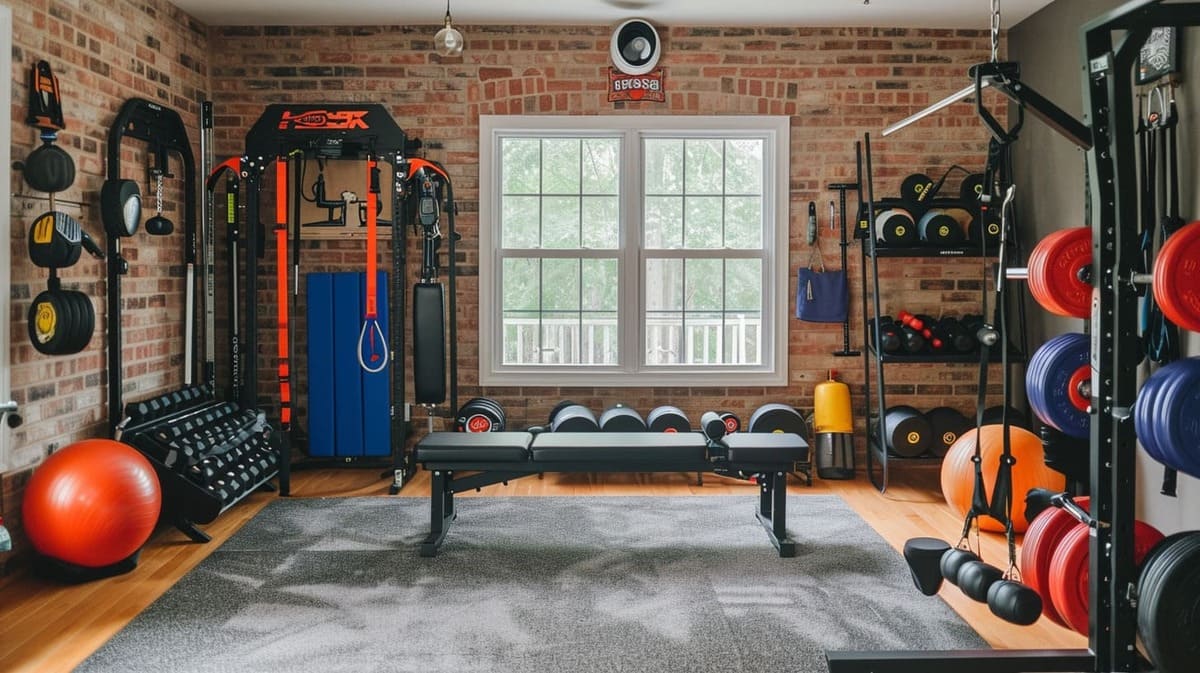In today’s fast-paced world, finding time to hit the gym for a boxing workout can be a challenge. With the right equipment and guidance, training at home can be an effective and convenient alternative. In this comprehensive guide, we’ll explore the benefits of home boxing drills and the essential equipment you’ll need to get started. Whether you’re a beginner looking to learn the basics or an experienced boxer seeking advanced drills, we’ve got you covered. We’ll also provide tips on creating a personalized home boxing workout plan to help you achieve your fitness goals. So, grab your gloves and let’s get ready to unleash your inner fighter from the comfort of your own home.
Key Takeaways:
- Incorporating boxing drills into your at-home workout routine can improve your overall fitness and coordination.
- Basic drills such as shadow boxing, jump rope warm-up, and punching bag work are great for beginners to build strength and technique.
- For experienced boxers, advanced drills such as speed bag work, focus mitt work, and sparring can enhance speed, agility, and accuracy.
Why Train Boxing at Home?
Training boxing at home offers numerous benefits, including the flexibility of scheduling workouts, personalized training techniques, and the comfort of familiar surroundings.
One of the key advantages of home boxing training is the convenience it provides. The ability to create a workout schedule that fits seamlessly into your daily routine not only saves time but also ensures consistency in your training.
Home training allows for adaptable workout routines, tailored to one’s specific needs and fitness goals. In a familiar environment, individuals can focus on honing specific boxing techniques, working on footwork, speed, and power without any distractions.
What Equipment Do You Need for Home Boxing Drills?

To effectively engage in home boxing drills, certain essential equipment is necessary to facilitate training and enhance skill development.
Boxing gloves are crucial for protecting hands during impact and minimizing the risk of injury. Hand wraps provide additional wrist and hand support, reducing the likelihood of sprains or strains.
Using a jump rope can improve footwork, agility, and cardiovascular endurance. A sturdy punching bag allows for practicing combinations, power punches, and refining technique.
Boxing Gloves
Boxing gloves are a fundamental piece of equipment for training, providing protection for the hands and wrists while ensuring proper form and technique during workouts.
They play a essential role in safeguarding boxers from injuries and bruises during sparring sessions or bag work. Boxing gloves are vital for skill development as they help in enhancing speed, power, and precision of punches. They aid in refining punching technique by promoting correct hand alignment and wrist support. Wearing the right gloves also contributes to the overall conditioning of the boxer’s arms and shoulders.
Hand Wraps
Hand wraps are essential for proper wrist support and hand protection during boxing drills, minimizing the risk of injuries and providing stability for impactful training sessions.
They are specifically designed to protect the bones and tendons in the hands and wrists by providing additional support and compression. By stabilizing the hand and wrist, hand wraps reduce the likelihood of sprains, strains, and other related injuries. This is crucial for boxers as it allows them to engage in intense training sessions without compromising their hand and wrist health.
Hand wraps also contribute to maintaining proper form and technique during punches by keeping the wrist in a neutral position, ultimately enhancing the effectiveness of the training. Thus, they play a vital role in preventing serious injuries and enhancing the overall stability and protection during boxing training.
Jump Rope
The jump rope is an essential tool for home boxing drills, enabling effective warm-ups, footwork enhancement, and cardio conditioning essential for boxing skill development.
Many boxers use jump ropes as a fundamental part of their training routine, as it offers numerous benefits. A key advantage is the improvement of footwork, as the rhythmic skipping helps develop agility, balance, and timing, essential components of boxing footwork. The repetitive motion of jumping rope aids in building endurance and cardiovascular conditioning, crucial for lasting through intense bouts in the ring. Incorporating jump rope exercises as part of warm-up routines can help maximize performance and reduce the risk of injury during training or matches.
Punching Bag
A punching bag is a cornerstone of home boxing drills, providing a platform for power development, technique refinement, and endurance training crucial for boxing proficiency.
It serves as a dynamic tool for boxers to develop the power in their punches, as they can practice striking with force and speed, mimicking real fight scenarios. The bag allows them to finetune their techniques, such as footwork, body movement, and striking accuracy, leading to an overall improvement in their boxing skills.
The repetitive impact on the bag aids in enhancing endurance and stamina, as boxers engage in prolonged sessions of striking, simulating the physical demands of a boxing match. This targeted training helps them build the physical and mental fortitude required to endure rounds of intense fighting.
Basic Boxing Drills for Beginners
Basic boxing drills cater to beginners, focusing on foundational techniques, footwork, and shadowboxing to instill fundamental skills and form the basis of boxing proficiency.

Shadowboxing, in particular, is a crucial component of beginner boxing training, as it allows individuals to practice various punches, footwork, and defensive maneuvers without a physical opponent. Footwork exercises, such as agility ladder drills and cone drills, enhance a boxer’s movement, positioning, and balance in the ring. Mastering fundamental techniques like the jab, cross, hook, and uppercut through repetition and focus establishes a strong foundation for beginners to build upon.
Shadow Boxing
Shadow boxing serves as a fundamental exercise for beginners, allowing them to practice technique, movement, and form without the need for additional equipment or a partner.
By engaging in shadow boxing, beginners can focus on refining their techniques and perfecting their movements. It enables them to build their foundational skills, such as footwork and coordination, while also enhancing their cardiovascular endurance. Shadow boxing provides an opportunity to visualize and practice specific boxing combinations, helping beginners to become more adept at executing these moves during actual bouts.
Jump Rope Warm-up
Incorporating jump rope warm-ups into beginner boxing drills aids in enhancing footwork, cardiovascular conditioning, and overall agility, laying the groundwork for effective training.
Jump rope warm-ups are particularly beneficial for beginners as they provide a dynamic way to improve their footwork and coordination. This low-impact exercise helps boxers develop essential skills while also boosting their cardio endurance.
By incorporating jump rope drills into their training routine, beginners can enhance their ability to move quickly and efficiently around the ring, a crucial aspect of boxing. This form of warm-up also plays a key role in building endurance and strength in the lower body, essential for performing well during intense bouts.
Jump rope warm-ups help beginners in developing rhythm and timing, which are fundamental to achieving precision and control in their movements. They also support the development of fast-twitch muscle fibers, contributing to improved reflexes and agility, crucial in evasive maneuvers and swift offensive actions.
Shadow Boxing with Weights
Incorporating weights into shadow boxing for beginners adds a dimension of strength and resistance training, promoting muscle development and enhancing overall boxing capabilities.
Shadow boxing with weights, when done correctly, can significantly improve a beginner’s punching power and speed. It engages different muscle groups, making it an effective full-body workout. The extra resistance from the weights challenges the muscles, leading to strength enhancement.
Incorporating weights adds an element of realism to the training, mimicking the feeling of punching against resistance encountered in an actual bout. This not only increases physical endurance but also improves punching accuracy and form, essential for beginners honing their boxing skills.
Punching Bag Work
Engaging in punching bag work introduces beginners to power generation, technique application, and endurance building, establishing a strong foundation for skill development.
This form of training provides beginners with the opportunity to develop and refine their boxing techniques, allowing them to strengthen their striking abilities and footwork. It aids in enhancing endurance levels and cardiovascular fitness through consistent practice. The repeated impact on the punching bag is instrumental in strengthening the muscles and improving overall power and strength. It is an ideal gateway for beginners to begin their journey in boxing and lay the groundwork for future advancement in the sport.
Advanced Boxing Drills for Experienced Boxers
Advanced boxing drills are tailored for experienced boxers, encompassing dynamic techniques, partner drills, and sparring sessions to refine and elevate their existing skill set.

Partner drills are essential for advanced boxers as they enable them to sharpen their timing, accuracy, and defensive maneuvers while simulating real fighting scenarios. These drills not only build camaraderie and trust but also foster adaptability and strategic thinking crucial in competitive bouts.
Incorporating unconventional angles and footwork in sparring sessions offers advanced boxers the opportunity to diversify their offensive and defensive tactics, thereby enhancing their overall proficiency and ring IQ.
Speed Bag Work
Speed bag work represents an advanced drill focusing on hand-eye coordination, rhythm, and precision, necessitating a high level of skill and dexterity from experienced boxers.
Boxers engaging in speed bag work must seamlessly synchronize their hand movements with the bag’s rhythm, requiring a finely tuned sense of timing and accuracy. This drill not only hones technical prowess but also enhances coordination and rhythm, crucial elements in a boxer’s arsenal.
The repetitive nature of speed bag training fosters a boxer’s ability to maintain focus and rhythm under pressure, potentially leading to enhanced performance during high-speed, high-pressure bouts.
Double End Bag Work
Double end bag work is an advanced training drill that emphasizes precision, timing, and accuracy, challenging experienced boxers to refine their control and targeting abilities.
When engaging with the double end bag, boxers must exhibit precise hand-eye coordination and footwork to strike the moving target effectively. The rapid movements of this specialized bag require boxers to develop acute timing, helping them anticipate and react to unpredictable movements in the ring.
This advanced drill also aids in enhancing boxing accuracy by promoting accurate striking and defensive maneuvers under dynamic conditions, leading to refined muscle memory and overall skill mastery.
Focus Mitt Work
Focus mitt work involves intricate partner drills designed to refine technique, speed, and combination execution, demanding a high level of proficiency and coordination from experienced boxers.
This advanced training method requires precise timing and expert hand-eye coordination, wherein the boxer reacts to visual cues provided by the trainer, simulating real match scenarios. It’s integral in honing defensive maneuvers, working on evasive footwork, and mastering counterattacks, elevating the boxer’s overall defensive prowess.
Sparring
Sparring sessions stand as the pinnacle of advanced boxing drills, facilitating realistic combat scenarios, strategic application of techniques, and partner interaction for experienced boxers.
Through sparring, a seasoned boxer can refine their offensive and defensive strategies in live, dynamic situations, honing their ability to anticipate and react to their opponent’s movements. It also enables them to test the effectiveness of their footwork, timing, and combinations in a controlled yet challenging environment.
Sparring fosters a deep sense of trust and camaraderie between boxing partners, as they jointly work towards improvement, providing invaluable feedback and encouragement to each other.
Sparring is essential for advanced boxers, offering a multifaceted platform for practical skill application, strategic refinement, and collaborative growth.
How to Create a Home Boxing Workout Plan
Crafting an effective home boxing workout plan involves setting realistic goals, selecting the right drills, incorporating rest and recovery, and tracking progress to optimize training outcomes.

When setting your goals, consider your fitness level and the specific areas of boxing you want to improve. Once your goals are in place, focus on selecting drills that target those areas, such as footwork, striking, and defense.
Integrate rest days into your schedule to allow your body to recover and prevent burnout. Tracking your progress is vital for staying motivated and adjusting your plan as needed. Remember, consistency and dedication are key to seeing results from your home boxing workout plan.
Set Realistic Goals
Establishing realistic and achievable goals forms the cornerstone of a home boxing workout plan, providing clear direction and motivation for consistent progress and skill development.
Setting specific goals in boxing serves as a roadmap for improvement, allowing individuals to break down their overall objective into manageable steps. By defining desired outcomes, such as improving speed, agility, or endurance, participants can personalize their training to focus on areas that need the most attention.
These goals act as benchmarks, enabling individuals to track their progress and adjust their regimen as needed. Setting goals enhances motivation, as each achievement signifies advancement towards mastering boxing techniques and reaching fitness milestones. Clear goals provide a sense of purpose during workouts and ensure that training remains focused and impactful.
Choose the Right Drills
Selecting the appropriate drills tailored to individual needs and skill levels is vital for a successful home boxing workout plan, ensuring variety, skill enhancement, and engagement.
The right selection of drills can add an exciting dimension to your training regimen, keeping you motivated and focused. It also allows you to work on different aspects of boxing, such as footwork, speed, power, and defensive techniques, ensuring a well-rounded development. Varying the drills prevents monotony, keeping your interest piqued and your sessions dynamic.
By incorporating a mix of bag work, pad drills, and sparring exercises, you can make your home workouts effective and rewarding.
Incorporate Rest and Recovery
Integrating adequate rest and recovery periods into a home boxing workout plan is essential for physical recuperation, muscle repair, and sustained training longevity.
Rest and recovery play a vital role in allowing the body to replenish energy stores, repair damaged tissues, and adapt to the stress of intense boxing workouts. Without sufficient recovery, the risk of overtraining and injury increases, hindering progress and performance. Including rest days in the training regimen helps prevent burnout and mental fatigue, fostering a sustainable and balanced approach to long-term physical fitness.
Track Your Progress
Monitoring and tracking progress in a home boxing workout plan allows for the evaluation of improvement, skill development, and the identification of areas for focused enhancement.
By keeping a record of your performance, you can pinpoint strengths and weaknesses, assess speed, power, and technique, and set targeted goals for iterative development. Progress tracking is crucial in maintaining motivation and commitment, while providing valuable insights into the effectiveness of your training regimen.
Frequently Asked Questions
What are some basic boxing drills I can do at home?
Some basic boxing drills you can do at home include shadowboxing, jumping rope, and practicing footwork and head movement.
Can I improve my boxing skills by doing drills at home?
Yes, consistent training and practice of drills at home can improve your boxing skills, including speed, agility, and technique.
How can I incorporate strength training into my boxing drills at home?
You can incorporate strength training into your boxing drills at home by using resistance bands, weighted gloves, or incorporating bodyweight exercises such as push-ups and squats.
Are there any specific boxing drills I can do to improve my defense?
Yes, you can practice slipping, bobbing and weaving, and blocking drills at home to improve your defense in boxing.
What equipment do I need to do boxing drills at home?
You can do basic boxing drills at home with minimal equipment such as gloves, hand wraps, a jump rope, and a space to move and practice footwork.
Can I do boxing drills at home without a partner?
Yes, you can do many boxing drills at home without a partner, including shadowboxing, footwork drills, and working on a heavy bag or a double-ended bag.

